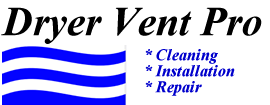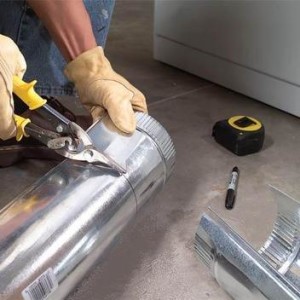We are a Fully Certified to install your Dryer Vent System.
Having us properly install your dryer vent system will ensure that your dryer operates safely and efficiently. Dryer lint is flammable, and the more that accumulates in the dryer and the duct, the greater the risk. The most obvious deterrent to this is to have your dryer vent system properly installed. Building codes are in place for your safety that is why our professional dryer vent installations exceed current building codes.
A dryer vent system is designed to remove heat, moisture and lint from your dryer and if you have a gas dryer it also exhausts carbon monoxide which can be life threatening. Improper venting can cause a dryer fire and could lead to carbon monoxide poisoning.
Homeowners have been known to replace their dryer because they think it isn’t drying properly, when in reality most of the time the dryer vent system is the problem. The cost of repairing or replacing a dryer vent system may be a fraction of the cost of a new dryer. Buying a new dryer will not make the dryer vent system operate more efficiently it will also operate badly if the dryer vent system is malfunctioning or dirty. If you are having problems with your dryer vent system, give us a call, we can help.
Improper Materials Used for Venting
Improper installations on dryer ducts are rampant. The most obvious, and possibly most common defect, is plastic dryer ducts. Plastic is not 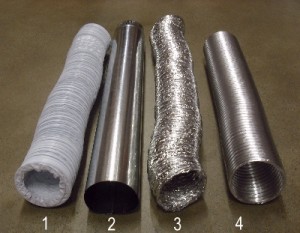 allowed for dryer ducts because lint can easily accumulate in the duct in its corrugated winding and when it sags, and besides that, plastic will not contain a fire. Flexible foil ducts are not much better than plastic because they are shiny material posing as aluminum foil but most is nothing more that shiny plastic and highly flammable. Any plastic or aluminum foil dryer ducts should be considered a potential fire hazard, and should be replaced with rigid metal. If flexible material must be used, the code says it should be limited to a maximum of eight feet, and flexible metal should be used in transitions. In the picture below I’ve included four types of pipe for you to familiarize yourself with. They are numbered here for easy reference. Two are recommended and two are rejected by state codes.
allowed for dryer ducts because lint can easily accumulate in the duct in its corrugated winding and when it sags, and besides that, plastic will not contain a fire. Flexible foil ducts are not much better than plastic because they are shiny material posing as aluminum foil but most is nothing more that shiny plastic and highly flammable. Any plastic or aluminum foil dryer ducts should be considered a potential fire hazard, and should be replaced with rigid metal. If flexible material must be used, the code says it should be limited to a maximum of eight feet, and flexible metal should be used in transitions. In the picture below I’ve included four types of pipe for you to familiarize yourself with. They are numbered here for easy reference. Two are recommended and two are rejected by state codes.
- This is plastic or vinyl flexible pipe and is not recommended for dryers and it is easy for fire to spread
- This is the rigid aluminum or galvanized pipe with smooth interior recommended by State Code.
- This is a flexible aluminium foil and is not recommended for use in dryer vents -easy for fire to spread .
- This is flexible metal galvanized pipe and can be used for transitions.
Dryer duct construction – It is important that dryer ducts vent to the exterior of the home and not into attics or other enclosed areas which can become a breeding ground for molds. The code says they should be made from metal, at least 4″ in diameter, and have a smooth interior. The entire duct needs to be supported and secured, and no screws are allowed on the joints because they could accumulate lint. By code flexible materials, such as foil, plastic, and semi-rigid metal are not allowed in order to eliminate potential fire hazards.
Here are some of the stats we observe from the International Residential Code book:
- All dryer ducting must be a minimum of 4″ in diameter. Clean, unobstructed, friction less ducts encourage air flow efficiency, quickens drying times, adds longevity to clothing’s life and reduces utility bills.
- Flexible transition hose between the dryer and the wall outlet should be either the foil type or the aluminum flexible duct (most preferred). Do not use the plastic or vinyl.
- Concealed ducting must be rigid metal (galvanized or aluminum) duct.
- Duct joints shall be installed so that the male end of the duct points in the direction of the airflow.
- Joints should be secured with metal tape (not duct tape). Do not use rivets or screws in the joints or anywhere else in the duct as these will encourage lint collection.
- Length of concealed rigid metal ducting shall not exceed 25 feet. Deduct 5 feet from the allowable length for every 90 degree elbow and two and a half feet for every 45 degree fitting.
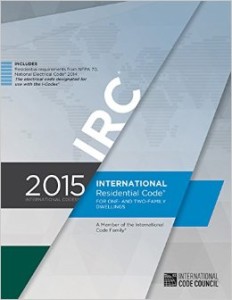
- Concealed ducting must be rigid metal (galvanized or aluminum) duct.
- Duct joints shall be installed so that the male end of the duct points in the direction of the airflow.
- Joints should be secured with metal tape (not duct tape). Do not use rivets or screws in the joints or anywhere else in the duct as these will encourage lint collection.
- Dryer venting shall be independent of any other systems (chimneys or exhaust vents)
- Termination of dryer venting must be to the exterior with a proper hood or roof jack equipped with a backdraft damper. Small orifice metal screening should not be part of the hood or roof jack as this will catch lint and block the opening in a very short time. The hood opening should point down and exhibit 12 inches of clearance between the bottom of the hood and the ground or other obstruction.
PVC Ducting should not be used for dryer vent exhaust.
M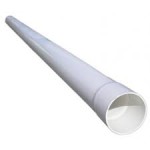 any contractors unknowingly think one pipe is as good as another and that simply is not the case. PVC pipe creates its own problems when used as exhaust pipe for dryer venting. Although it is smooth on the inside it is not appropriate for exhausting hot moist air and lint . There is a static charge that is created in plastic pipe which causes the lint to cling together and with added moisture content it causes the lint to cling to the walls of PVC pipe which over time, inevitably leads to a blockage in the PVC pipe. It is better to avoid PVC for dryer vent exhaust and use the recommended rigid metal ducting instead.
any contractors unknowingly think one pipe is as good as another and that simply is not the case. PVC pipe creates its own problems when used as exhaust pipe for dryer venting. Although it is smooth on the inside it is not appropriate for exhausting hot moist air and lint . There is a static charge that is created in plastic pipe which causes the lint to cling together and with added moisture content it causes the lint to cling to the walls of PVC pipe which over time, inevitably leads to a blockage in the PVC pipe. It is better to avoid PVC for dryer vent exhaust and use the recommended rigid metal ducting instead.
Back-draft Damper Must be Used.
Wherever the dryer duct vents to the outside it needs to have a back-draft damper. This keeps intruders out when properly maintained. Also there should be no screens included at the end of the dryer exhaust vent. Some people install screens because they are concerned about animals getting into the dryer duct work. However if the back-draft damper is maintained through regular cleaning, this should not be a problem. 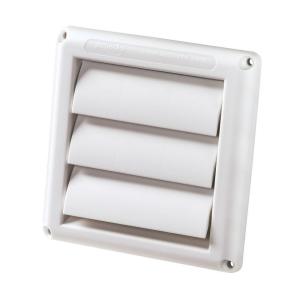 When screens are installed, they can easily get clogged with lint. This will obviously reduce your dryer’s effectiveness to eliminate the moist hot air and create a blockage which becomes a potential fire hazard.
When screens are installed, they can easily get clogged with lint. This will obviously reduce your dryer’s effectiveness to eliminate the moist hot air and create a blockage which becomes a potential fire hazard.
Good Practices to Observe
Periodically check the damper at the exterior to make sure it’s clean; when lint accumulates at the damper it will eventually cause the damper to stay open. If you’re unfortunate enough to have a dryer that exhausts through the roof… you will need Dryer Vent Pro to clean that for you because someone needs to get up to the roof line on a regular basis to clean the damper and our professional company has the tools to do so.
Very often a dryer duct may be routed through a wall into a concealed area of the home, such as an attic or crawl space, you should check on it regularly to make sure that everything is functioning properly and is still connected. A disconnected clothes dryer duct will release a considerable amount of lint and moisture in to the home. Therefore you should inspect those areas and also to Inspect behind your dryer to check for build up of lint- it is a common problem for the dryer to become disconnected from the duct because of the force from the dryer exhaust. This can create a pile of flammable lint behind the dryer. As a regular part of dryer maintenance; the dryer duct itself needs to be cleaned .
Another common installation defect is the length of the duct. The inspection code says that dryer ducts should be no longer than 25 feet. It states that for each 90 degree turn, you must subtract 5 feet. Many dryer ducts are configured so that they make a 90 degree turn when the duct comes out of the dryer. From there it may run up to the ground level if in a basement which may be another 8ft then again make another 90 degree turn to face the exit area for the exhaust. If you add the length it will take to reach the outside of the home you can see that it doesn’t take long to reach this maximum recommended length. It is important to refer to your dryer installation manual to determine the manufacturers recommendation. The code says the manufacturer has the last say as to how far the dryer length shall be and allows for a longer run if the manufacturer says it can do so.
Dryers are the number 1 source of fire in the home!
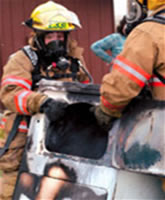 In 1999 the U.S. Consumer Product Safety Commission (USCPC) developed a report called the “Report on Electric and Gas Clothes Dryers.” In that report they determined that of the 15,000 fires studied in one year, electric dryers were over 2.5 times more likely to be the cause of the fire than gas dryers.
In 1999 the U.S. Consumer Product Safety Commission (USCPC) developed a report called the “Report on Electric and Gas Clothes Dryers.” In that report they determined that of the 15,000 fires studied in one year, electric dryers were over 2.5 times more likely to be the cause of the fire than gas dryers.
Most people don’t realize that dryer lint is extremely flammable and can lead to a dryer fire that can rapidly spread throughout your home.
Take time for peace of mind and give us a call TODAY!
Phone us now at 401-954-1053 to schedule your dryer vent installation.
